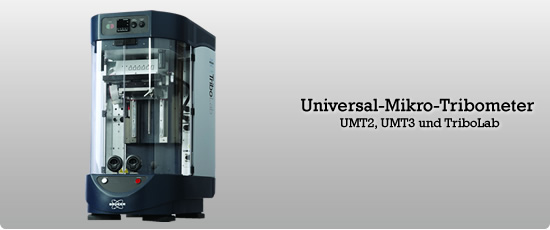The universal micro tribometer

CETR’s Universal Micro Tribometer (UMT) can be adapted to almost any tribological test task by a variety of available measuring modules. In addition to simple model tests, component tests with complex stress types are possible. Encoder-controlled measuring axes guarantee maximum precision. Different force sensors enable highly accurate measurements over several orders of magnitude. The institute has three devices (UMT2, 3 and Tribolab) as well as numerous motion modules with which purely rotational as well as oscillating linear motions are possible.
In addition, the instrument can also be used to carry out various types of scratch tests on coatings (in accordance with DIN EN 1071-3).
| Test bench parameters | ||
| Speed (rotation) | 0.1 to 5,000 1/min | |
| Frequency (oscillation) | 0.1 to 25 Hz | |
| Load | 0.05 to 5 N (resolution 5 mN) 2 to 200 N (resolution 0.2 N); UMT 3 to 1000 N | |
| Temperature | 0°C to approx. 80°C | |
| Traversing options of the upper specimen holder | in Z direction – 150 mm (resolution 2 µm) in X direction – 150 mm (resolution 0.5 µm) |
|
| Traversing speed the traverse |
0.001 to 10 mm/s (X direction) | |
| Stroke (oscillation) | 0.01 to 10 mm (Y direction) | |
| Movement types | Glide (rotation, oscillation) | |
| Friction conditions | Solid state, boundary and mixed friction, elastohydrodynamics, hydrodynamics | |
| Contact geometry | Point, line and surface contact | |
| Measured variables | Friction value, torque, linear wear amount; Acoustic Emission |
Other tests
- Investigation of stick-slip effects
- Precision measurements of friction force and coefficient of friction
- Performance of friction and wear tests on ferrous and non-ferrous metals, plastics, ceramics, composites and coatings, with and without lubricants, e.g. following ASTM D 3702 Standard Test Method for Wear Rate and Coefficient of Friction of Materials in Self Lubricated Rubbing Contact Using a Thrust Washer Testing Machine or ASTM G 99: Standard Test Method for Wear Testing with a Pin-on-Disk Apparatus.
- Tribological testing of both solid and liquid lubricants, oils and greases
- Screening tests for various lubricants
- Scratch tests based on DIN EN 1071-3 (“Advanced ceramics – Methods of testing ceramic coatings, Part 3: Determination of adhesion and shapes of mechanical failure by the scratch test”)
- Abrasive wear tests based on ASTM G 132: Standard Test Method for Pin Abrasion Testing
Possible specimen geometries


